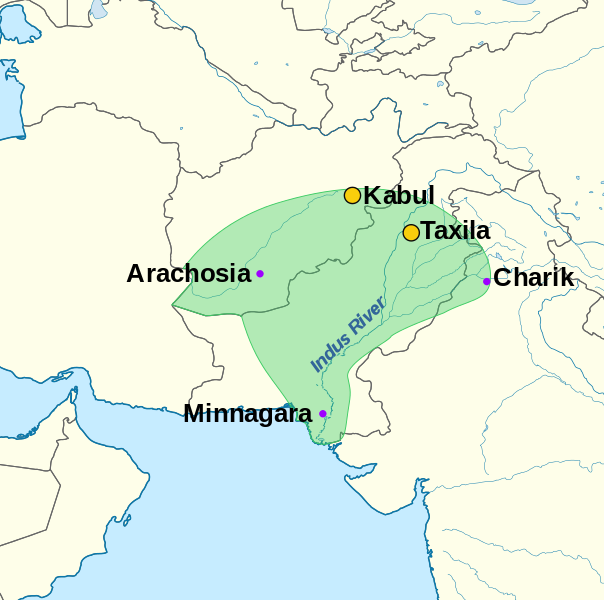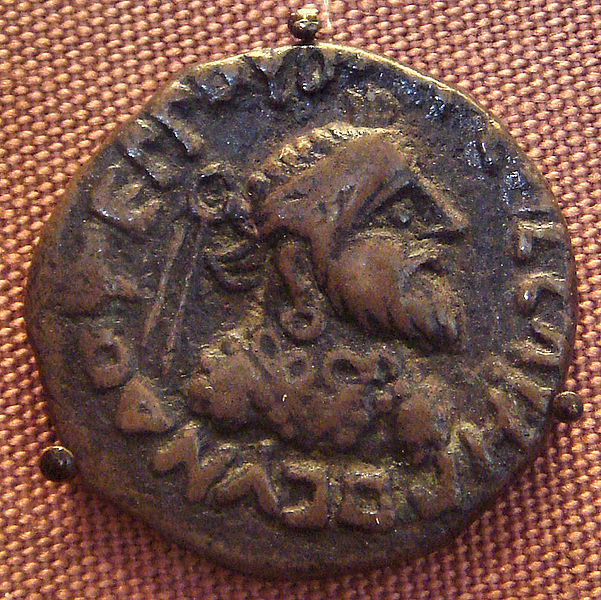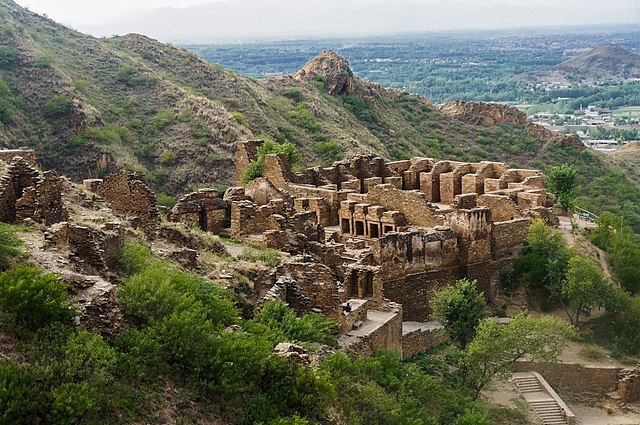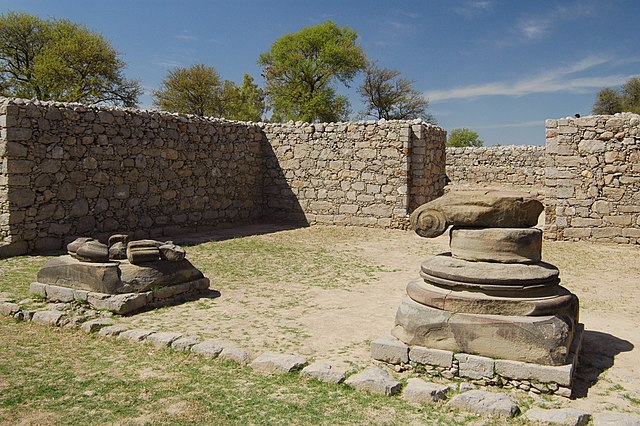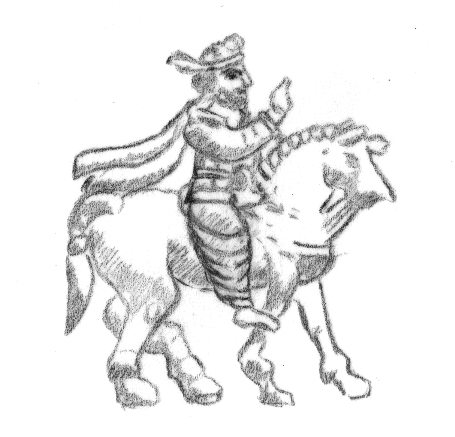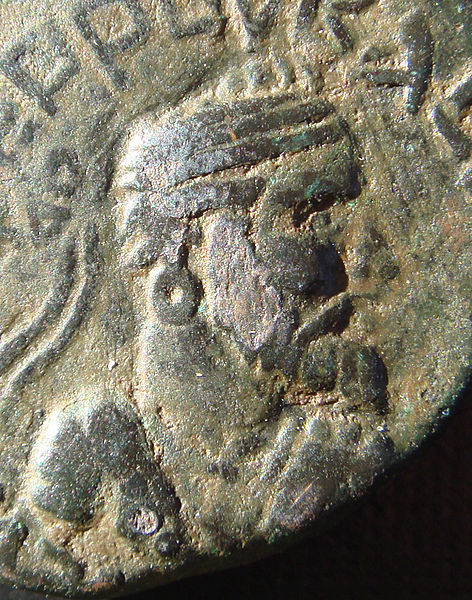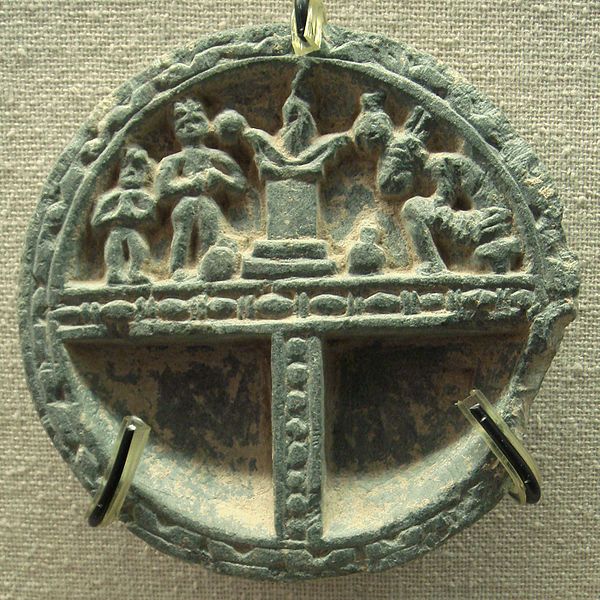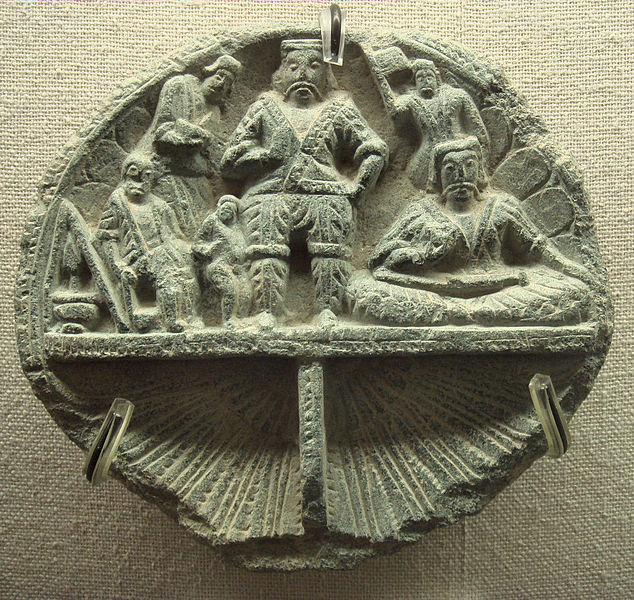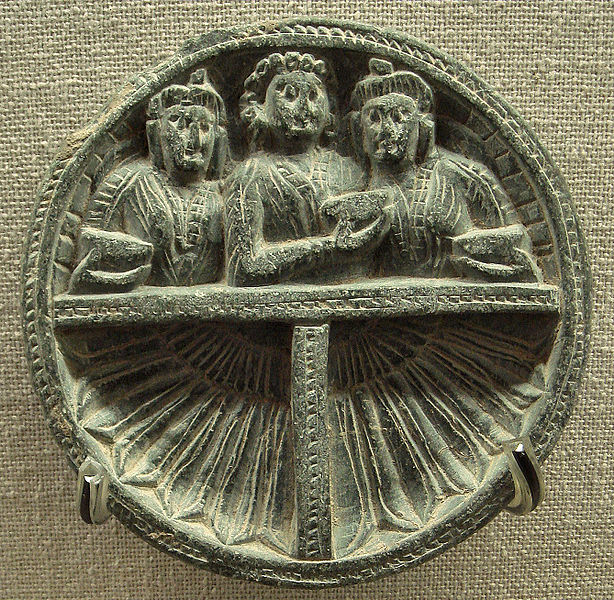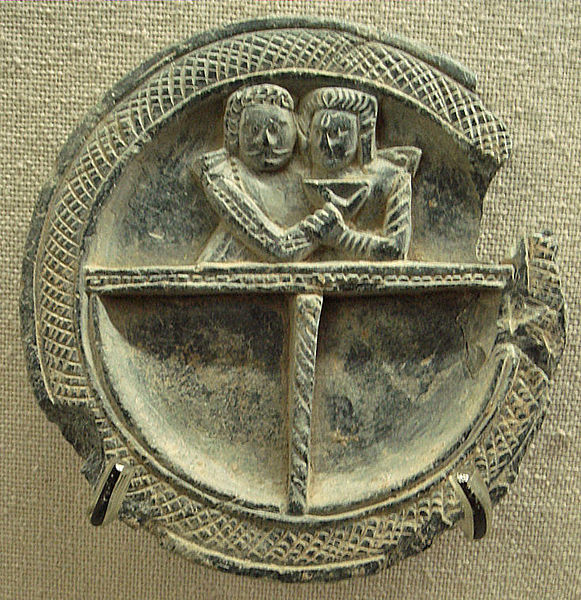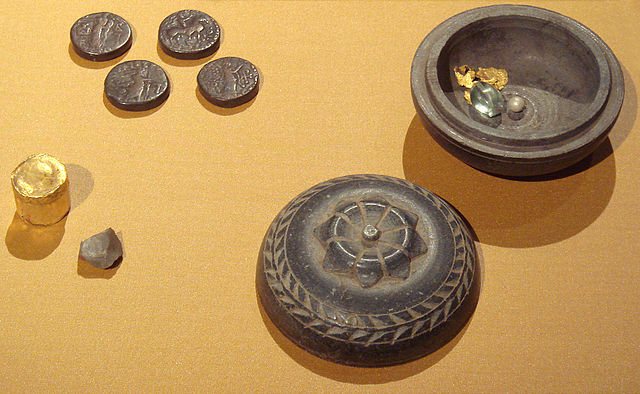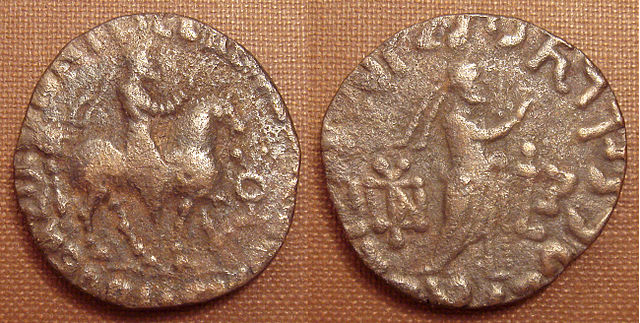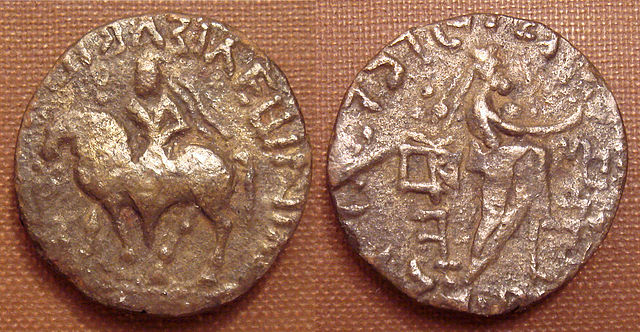
| INDO - PARTHIAN KINGDOM
Indo-Parthian Kingdom at its maximum extent Indo-Parthian Kingdom
Capital : Taxila and Kabul
Common languages : Aramaic, Greek, Pali (Kharoshthi script), Sanskrit, Prakrit (Brahmi script) and Parthian
Religion : Buddhism, Hinduism and Zoroastrianism
Government : Monarchy
King
• 19 - 46 : Gondophares I (first)
• ? - 226 : Farn-Sasan (last)
Historical era
• Gondophares I : 19
• Disestablished : 226
Preceded by
Parthian Empire
Indo-Scythians
Succeeded by
Kushan Empire
Sasanian Empire
The Indo-Parthian Kingdom, also known as the Suren Kingdom, was a Parthian kingdom founded by the Gondopharid branch of the House of Suren, ruling from 19 to c. 226. At their zenith, they ruled an area covering parts of eastern Iran, various parts of Afghanistan and the northwest regions of the Indian subcontinent (most of modern Pakistan and parts of northwestern India).
The kingdom was founded in 19 when the Surenid governor of Drangiana (Sakastan) Gondophares declared independence from the Parthian Empire. He would later make expeditions into the west, conquering territory from the Indo-Scythians and Indo-Greeks, thus transforming his kingdom into an empire. The domains of the Indo-Parthians were greatly reduced following the invasions of the Kushans in the second half of the 1st. century. They managed to retain control of Sakastan, until its conquest by the Sasanian Empire in c. 224/5.
The Indo-Parthians are noted for the construction of the Buddhist monastery Takht-i-Bahi (UNESCO World Heritage Site).
Gondophares I and his successors :
Portrait of Gondophares, founder of the Indo-Parthian kingdom. He wears a headband, earrings, a necklace, and a cross-over jacket with round decorations
King Abdagases I being crowned by the Greek goddess Tyche, on the reverse of some of his coins Gondophares I originally seems to have been a ruler of Seistan in what is today eastern Iran, probably a vassal or relative of the Apracarajas. Around 20–10 BC, he made conquests in the former Indo-Scythian kingdom, perhaps after the death of the important ruler Azes. Gondophares became the ruler of areas comprising Arachosia, Seistan, Sindh, Punjab, and the Kabul valley, but it does not seem as though he held territory beyond eastern Punjab. Gondophares called himself "King of Kings", a Parthian title that in his case correctly reflects that the Indo-Parthian empire was only a loose framework: a number of smaller dynasts certainly maintained their positions during the Indo-Parthian period, likely in exchange for their recognition of Gondophares and his successors. These smaller dynasts included the Apracarajas themselves, and Indo-Scythian satraps such as Zeionises and Rajuvul, as well as anonymous Scythians who struck imitations of Azes coins. The Ksaharatas also held sway in Gujarat, perhaps just outside Gondophares' dominions.
Ancient Buddhist monastery Takht-i-Bahi (a UNESCO World Heritage Site) constructed by the Indo-Parthian After the death of Gondophares I, the empire started to fragment. The name or title Gondophares was adapted by Sarpedones, who become Gondophares II and was possibly son of the first Gondophares. Even though he claimed to be the main ruler, Sarpedones’ rule was shaky and he issued a fragmented coinage in Sind, eastern Punjab and Arachosia in southern Afghanistan. The most important successor was Abdagases, Gondophares’ nephew, who ruled in Punjab and possibly in the homeland of Seistan. After a short reign, Sarpedones seems to have been succeeded by Orthagnes, who became Gondophares III Gadana. Orthagnes ruled mostly in Seistan and Arachosia, with Abdagases further east, during the first decades AD, and was briefly succeeded by his son Ubouzanes Coin. After 20 AD, a king named Sases, a nephew of the Apracaraja ruler Aspavarma, took over Abdagases’ territories and became Gondophares IV Sases. According to Senior, this is the Gondophares referred to in the Takht-i-Bahi inscription.
There were other minor kings: Sanabares was an ephemeral usurper in Seistan, who called himself Great King of Kings, and there was also a second Abdagases Coin, a ruler named Agata in Sind, another ruler called Satavastres Coin, and an anonymous prince who claimed to be brother of the king Arsaces, in that case an actual member of the ruling dynasty in Parthia.
But the Indo-Parthians never regained the position of Gondophares I, and from the middle of the 1st century AD the Kushans under Kujul Kadphises began absorbing the northern Indian part of the kingdom. The Indo-Parthians managed to retain control of Sakastan, which they ruled until the fall of the Parthian Empire by Sasanian Empire.
Archaeology and sources :
The Hellenistic temple with Ionic columns at Jandial, Taxila, is usually interpreted as a Zoroastrian fire temple from the period of the Indo-Parthians The city of Taxila is thought to have been a capital of the Indo-Parthians. Large strata were excavated by Sir John Marshall with a quantity of Parthian-style artifacts. The nearby temple of Jandial is usually interpreted as a Zoroastrian fire temple from the period of the Indo-Parthians.
Some ancient writings describe the presence of the Indo-Parthians in the area, such as the story of Saint Thomas the Apostle, who was recruited as a carpenter to serve at the court of king "Gudnaphar" (thought to be Gondophares) in India. The Acts of Thomas describes in chapter 17 Thomas' visit to king Gudnaphar in northern India; chapters 2 and 3 depict him as embarking on a sea voyage to India, thus connecting Thomas to the west coast of India.
As Senior points out, this Gudnaphar has usually been identified with the first Gondophares, who has thus been dated after the advent of Christianity, but there is no evidence for this assumption, and Senior's research shows that Gondophares I could be dated even before 1 AD. If the account is even historical, Saint Thomas may have encountered one of the later kings who bore the same title.
Gondophares on horse, from his coinage. He wears a short jacket and baggy trousers, rather typical of Parthian clothing
Portrait on Gondophares on one of his coins The Greek philosopher Apollonius of Tyana is related by Philostratus in Life of Apollonius Tyana to have visited India, and specifically the city of Taxila around 46 AD. He describes constructions of the Greek type,probably referring to Sirkap, and explains that the Indo-Parthian king of Taxila, named Phraotes, received a Greek education at the court of his father and spoke Greek fluently:
"Tell
me, O King, how you acquired such a command of the Greek tongue,
and whence you derived all your philosophical attainments in this
place?"
"This
river (Indus) has seven mouths, very shallow and marshy, so that
they are not navigable, except the one in the middle; at which by
the shore, is the market-town, Barbaricum. Before it there lies
a small island, and inland behind it is the metropolis of Scythia,
Minnagara; it is subject to Parthian princes who are constantly
driving each other out." Periplus of the Erythraean Sea, Chap
38
Religion of the Indo-Parthians :
Devotees at Zoroastrian fire-altar We do not know the religion of the House of Suren although we know they were in religious conflict with the Zoroastrian Arsacid Dynasty. Unlike the Indo-Greeks or Indo-Scythians, there are no explicit records of Indo-Parthian rulers supporting Buddhism, such as religious dedications, inscriptions, or even legendary accounts. Also, although Indo-Parthian coins generally closely follow Greek numismatics, they never display the Buddhist triratna symbol (apart from the later Sases), nor do they ever use depictions of the elephant or the bull, possible religious symbols which were profusely used by their predecessors. They are thought to have retained Zoroastrianism, being of Iranian extraction themselves. This Iranian mythological system was inherited from them by the later Kushans who ruled from the Peshawar-Khyber-Pakhtunkhwa region of Pakistan.
Coins of the Hindu deity Shiv have also been found issued in the reign of Gondophares I.
Representation of Indo-Parthian devotees :
Indo-Parthian King On their coins and in the art of Gandhar, Indo-Parthians are depicted with short crossover jackets and large baggy trousers, possibly supplemented by chap-like over-trousers. Their jackets are adorned with rows of decorative rings or medals. Their hair is usually bushy and contained with a headband, a practise largely adopted by the Parthians from the 1st century AD.
Individuals in Indo-Parthian attire are sometimes shown as actors in Buddhist devotional scenes. It is usually considered that most of the excavations that were done at Sirkap near Taxila by John Marshall relate to Indo-Parthian layers, although more recent scholarship sometimes relates them to the Indo-Greeks instead. These archaeological researches provided a quantity of Hellenistic artifacts combined with elements of Buddhist worship (stupas). Some other temples, such as nearby Jandial may have been used as a Zoroastrian fire temple.
Buddhist
sculptures :
Stone
palettes :
Very often these palettes represent people in Greek dress in mythological scenes, but a few of them represent people in Parthian dress (head-bands over bushy hair, crossed-over jacket on a bare chest, jewelry, belt, baggy trousers). A palette from the Naprstek Museum in Prague shows an Indo-Parthian king seated crossed-legged on a large sofa, surrounded by two attendants also in Parthian dress. They are shown drinking and serving wine.
Indo-Parthian man hunting
Indo-Parthian revelers
Indo-Parthian couple Silk Road transmission of Buddhism :
Some pockets of Parthian rule remained in the East, even after the takeover by the Sassanids in 226. From the 2nd century several Central-Asian Buddhist missionaries appeared in the Chinese capital cities of Loyang and sometimes Nanjing, where they particularly distinguished themselves by their translation work. The first known translators of Buddhist texts into Chinese are actually Parthian missionaries, distinguished in Chinese by their Parthian surname "An", for "Anshi", "country of the Arsacids".
•
An Shih Kao,
was a Parthian prince, who made the first known translations of
Hinayana Buddhist texts into Chinese (148–170).
Coins of the Indo-Parthian king Abdagases, in which his clothing is clearly apparent. He wears baggy trousers and a crossover jacket Main Indo-Parthian rulers :
•
Gondophares I
(c. 19 – 46) Coin
Source :
https://en.wikipedia.org/ |
